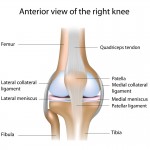Physiotherapy after knee replacement
A total knee replacement is an extremely common orthopaedic procedure. Normally knee replacements are performed on individuals who have a history of pain in the knee due to wear and tear in the knee joint. Your knee is a hinge joint, consisting of your femur (thigh bone), tibia (shin bone) and your patella (knee cap). Due to everyday life, we develop wear and tear in our knees. If the knee becomes quite painful due to wear and tear, it may be possible that you might have to get a knee replacement.
What happens during a knee replacement?
During a knee replacement, the ends of your femur (thigh bone) and the tibia (shin bone) are removed. Sometimes, the underside of the patella (knee cap) will also be removed. The new knee will consist of a metal shell on the end of the femur and a metal and plastic cover on the tibia. These new artificial parts are sometimes held in place with special cement.
After surgery, there is a lot of work to do to increase the strength, control and stability around the knee joint. As the knee was probably painful for some time, the muscles around the knee will be weak and tight. In order to get you back on your feet, a rehabilitation program consisting of exercises and hands on techniques will be devised in order to get you back to normal.
If you are about to have a knee replacement or have any questions about a knee replacement procedure, please do not hesitate to get in contact with us.





